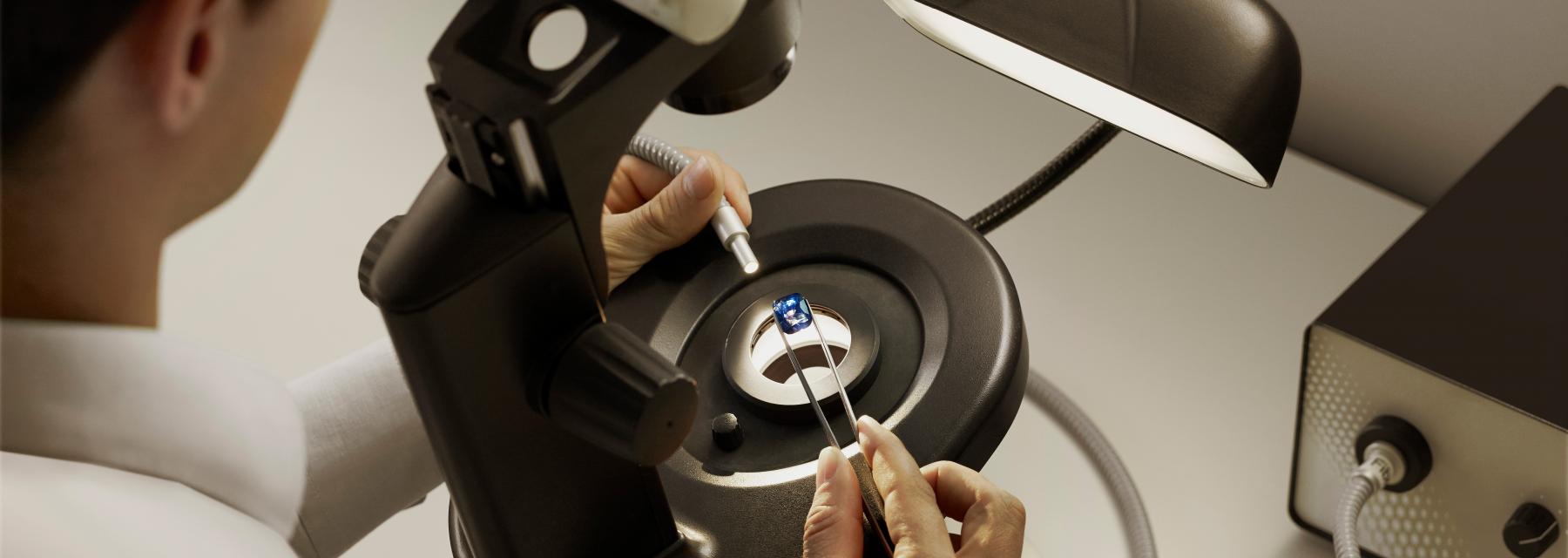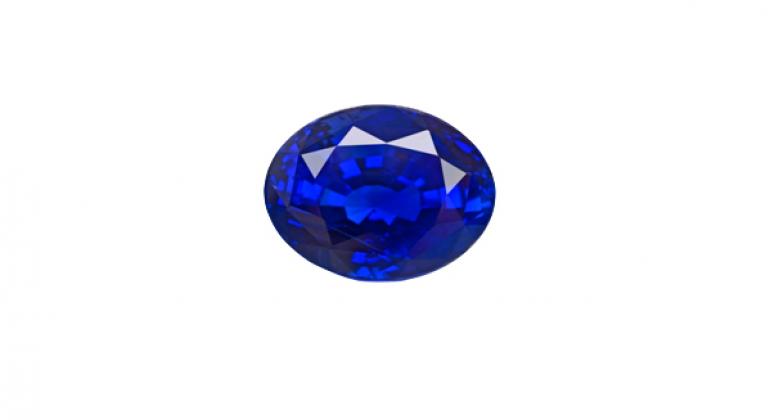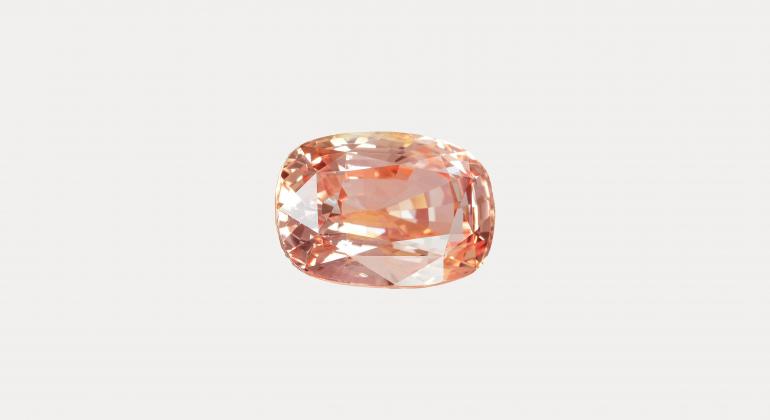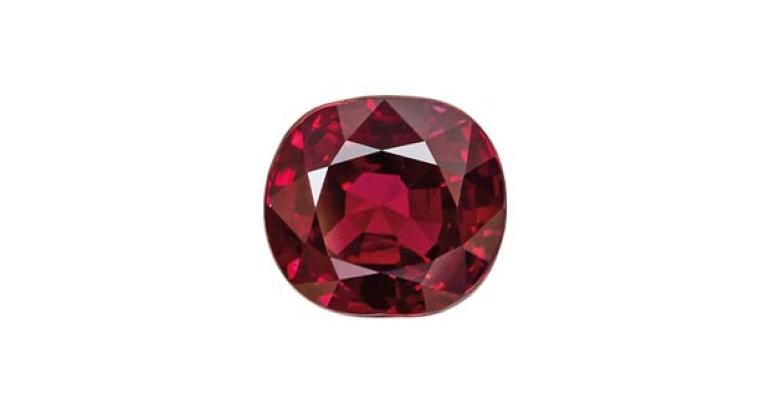
Gemstone Colour Terms
Differences in reports from different gem testing laboratories, and hence efforts to harmonise the work of labs, are notorious in our industry. Indeed, conflicting results pose a challenge to a seller, and might raise doubt in the stone and the seller alike. Debates about such inconsistencies typically relate to country of origin, but also to treatment status and colours, namely trade colours such as pigeonblood red or royal blue. There is a global consensus that harmonisation would be the right thing to do, but it does not happen. The Gübelin Gem Lab does pursue harmonisation, specifically for trade colour terms. However, not all labs are equally strict in the application of agreed definitions, limiting the result of these harmonisation efforts.
Historically, the gem trade uses dedicated terms to describe specific colours and qualities of gemstones. Such terms - often reflecting regional preferences – are typically assigned to gemstones of superior quality. They tend to blend colour attributes with other quality characteristics and rarity.
Since there is no definite agreement as to precise colours and quality criteria a stone has to fulfil, there is little consistency on how these trade colour terms are applied within the industry. Nonetheless, gem labs use these colour terms on their reports to fulfil the demand from the trade.
With the use of these terms by laboratories, an international standard and harmonisation becomes increasingly pressing to foster a more consistent application and finally to protect consumer confidence. Efforts to find a shared definition and interpretation of trade terms arose already years ago within the industry to work towards the harmonisation of standards to determine “royal blue” sapphires, “cornflower blue” sapphires, “pigeonblood red” rubies or even “Padparadscha” sapphires.
Hamonisation of trade colour terms
With the intention to bring clarity to the industry, the Gübelin Gem Lab and SSEF compared the other laboratory’s criteria for the colour terms “pigeon blood red” and “royal blue” and found them to largely coincide. In 2015 the Gübelin Gem Lab and the Swiss laboratory SSEF agreed to harmonise their definitions and testing procedures for “pigeon blood red” and “royal blue”. However, the exact application of these agreed-upon definitions and procedures, as well as a residual ambiguity in the strictness of interpretation poses a limitation to a complete harmonisation.
Hence, harmonisation efforts can merely reduce differences. As long as lab work continues to have an element of subjectivity, lab harmonisation remains an ambition only.
As one of the members of the Laboratory Manual Harmonisation Committee (LMHC), the Gübelin Gem Lab was and keeps also participating in the harmonisation of other colour-related trade names used in our industry, including those for padparadscha sapphire and paraiba tourmaline. The Gübelin Gem Lab welcomes and supports all efforts in this direction.
The Gübelin Gem Lab’s definition of trade colour terms
The Gübelin Gem Lab is known for applying the most rigorous and stringent standards in all its work. This also applies to the use of trade colour terms. Only terms that have a global recognition and a certain general understanding of its meaning get considered. These few terms are translated into a comprehensive list of gemmological and visual criteria. For a stone to qualify for such a term, it has to fulfil all the respective criteria, enabling a consistent application of these terms. The following paragraphs describe the trade terms that the Gübelin Gem Lab applies on its reports, and the underlying criteria a stone has to fulfil to qualify.
Pigeon Blood Red
Historically, the term “pigeon blood red” was applied for rubies of the highest quality from the Mogok Gemstone Tract in Burma (Myanmar). These rubies were formed in marbles of, and show a saturated red colour, intensified by a soft red glow under natural daylight. This glow is called fluorescence, and is caused by ultraviolet light that makes part of the spectrum of daylight. Such fluorescence is only possible in rubies characterised by a very low iron concentration. With the discovery of additional ruby deposits in marbles in Burma, such as at Mong Hsu, and also in other countries, this effect and hence this term is no longer restricted to rubies from the Mogok region. Nonetheless, most rubies from places other than Burma contain higher concentrations of iron that suppress fluorescence, and consequently do not comply with the labs’ criteria.
Colour criteria
For a ruby to qualify for the term “pigeon blood red”, the colour has to be an intense, saturated and homogeneous red. The exact ranges of hue, saturation and tone are defined by sets of masterstones.
“Pigeon blood red” is best described as a red colour, with no apparent colour modifiers (such as blue or brown). A minute purplish tint is acceptable. The body colour of pigeon blood red rubies is complemented by a strong fluorescence when exposed to ultraviolet light, as explained above. This fluorescence is caused by high chromium content combined with low iron content, and results in the distinct "inner glow" coveted by ruby connoisseurs.
Quality criteria
In terms of quality, these colour terms can only be applied to rubies that exhibit fine qualities, and have not undergone any modification of colour and/or clarity.
Any type of treatment (such as heating, fissure filling, etc.) disqualifies them from being described using this colour term. Furthermore, they must be relatively free of eye-visible or dark inclusions, and they must show a homogeneous colour distribution with vivid internal reflections.
The size of the stones is not considered a criterion, meaning that small rubies may qualify for these colour terms.

Royal Blue
Traditionally, the term royal blue was coined for high-quality blue sapphires from Burma (Myanmar), displaying a deeply saturated, blue colour, possibly complemented by a minute trace of purple.
Colour criteria
For a sapphire to qualify for the term “royal blue”, the colour has to be an intense, saturated and homogeneous blue. The exact ranges of hue, saturation and tone are defined by sets of masterstones.
“Royal blue” is best described as a saturated blue colour, either pure or with a very slight purplish tint. While “royal blue” is a term that was historically coined for the best quality of sapphires originating from the Mogok area in Burma, sapphires from other metamorphic deposits, such as those found in Madagascar and Sri Lanka, may also display the properties required to qualify for the “royal blue” term.
Quality criteria
In terms of quality, these colour terms can only be applied sapphires that exhibit fine qualities, and have not undergone any modification of colour and/or clarity.
Any type of treatment (such as heating, fissure filling, etc.) disqualifies them from being described using this colour term. Furthermore, they must be relatively free of eye-visible or dark inclusions, and they must show a homogeneous colour distribution with vivid internal reflections.
The size of the stones is not considered a criterion, meaning that small sapphires may qualify for these colour terms.

Padparadscha Sapphire
Originating from Sri Lanka, the term padparadscha is an alteration of the Singhalese padmaraga, combining padma (lotus flower) and raga (colour). It is believed to also refer to the colours of a tropical sunset. While Sri Lanka - or by its ancient names Ceylon or Serendip - is the original provenance of these stones, padparadscha sapphires are also found in other places including Madagascar, Tanzania or Vietnam.
Colour criteria
When it comes to the trade term “padparadscha sapphire”, the Gübelin Gem Lab adopts the definition of the LMHC. A padparadscha sapphire’s colour is best described as a subtle mixture of pinkish-orange to orangey-pink, typically with pastel tones. Yellow, purple or brown colour modifiers disqualify the sapphire of the colour term, as do major uneven colour distribution when viewed table up. Furthermore, padparadscha sapphires must pass the colour stability test.
Quality criteria
Both unheated and heated stones can qualify. Sapphires which have undergone advanced treatment techniques, i.e. involving methods such as lead-glass filling, lattice diffusion or irradiation are excluded from the denomination “padparadscha sapphire”. Standard heat treatment is considered acceptable. Stones that show a presence of yellow or orange epigenetic material in fissures, which affect the overall colour of the stones are not called padparadscha sapphires, even when all other conditions are met.

Crimson Red
The Gübelin Gem Lab has decided to apply a trade colour term for rubies displaying an ideal colour – identical to the colour of pigeon blood red rubies - combined with the best quality traits, while applying a different fluorescence criterion. The term crimson red was selected to accompany the best (rarest and most beautiful) rubies beyond fluorescence.
Colour criteria
Crimson describes a rich, saturated red colour, allowing also a minute admixture of purple.
In order to qualify for the crimson red colour call, first of all, the ruby must show the right hue, saturation and tone, evenly and homogeneously distributed across the stone. The stone must not show any major windowing or extinction.
Quality criteria
In terms of quality,it needs to be spared from any treatment. Faceted stones must possess a cut producing a lively brilliance. Both faceted and polished stones can qualify, as can gems showing asterism, however, a high transparency is required. Crimson red rubies must have little to no fluorescence in short-wave UV light (unlike pigeon blood red rubies).
Only the small share of high-quality untreated rubies, fulfilling all of these criteria, qualify for the trade colour term “crimson red”.

Crimson Red FAQ
-
Why is Gübelin Gem Lab introducing a new trade colour for rubies?
Trade colours help the trade and even more the final customer to distinguish the best – highest quality and rarest – specimens of a particular type of gemstones. Terms such as royal blue for sapphires, or pigeon blood red for rubies were based on the quality traits of stones from Burma(Myanmar). However, the global supply pattern has changed. Since more than 10 years, a large majority of high quality rubies entering the world market originate from Africa, particularly from Mozambique. With the launch of crimson red, the top-quality specimens of African rubies – typically lacking distinct fluorescence, but displaying a colour generally considered as ideal for rubies – get their proper trade colour designation.
-
Is the intention to promote African rubies?
Gem labs should not intend to directly promote a certain type of provenance of gemstones. But we can help the trade and even more the final customer to spot the extraordinary, by accompanying them with a trade colour “label”. It gives clients orientation and direction.
-
Is the introduction of a new trade colour required by the trade and/or a specific origin?
The lack of availability of a trade colour for a large majority of today’s ruby supply was our motivation to come up with a specific trade colour term. It is not particularly focusing on Mozambican stones, but generally rubies of outstanding colour and quality, which do not expose the level of fluorescence that their siblings from the marble-related deposits – such as the Himalayan region – typically do.
-
What is the difference between crimson red and pigeon blood red?
Pigeon blood red rubies, when exposed to short wave UV light, must expose a medium to strong fluorescence. That criterion does not apply for crimson red rubies. All other colour and quality criteria are identical.
-
Why is it called crimson red?
The colour definition and metrics of crimson red, as defined by the main bodies in charge of colour standards matches quite exactly the colour that is defined as ideal for ruby, and also applies to our interpretation of pigeon blood red. The term crimson has already been applied a number of times on exceptional rubies which we had the privilege to test in our lab. Which indicates that the term has a certain acceptance in the trade already, and is used in context with a coveted ruby colour and superior quality.
In other domains, particularly in biology, crimson is part of the name of a number of species, such as in Crimson Sunbird (Aethopyga siparaja), Crimson Rosella (Platycercus elegans), or the butterfly Crimson Rose (Pachliopta hector).



-
Is crimson red as rare as pigeon blood red?
We do not know yet. As the quality criteria for crimson red are as restrictive as for pigeon blood red, the amount of rubies accompanied by Gübelin Gem Lab reports stating crimson red might be very rare, too. It is important to state that less than 1 % of all rubies the Gübelin Gem Lab gets for testing do qualify for the pigeon blood red call. It can be assumed that the percentage of stones that will qualify for crimson red will not be much higher.
It remains our intention to maintain a very high threshold for any trade colour, indicating rarity and quality to buyers of such stones. -
Whom does a new trade colour help?
It helps the trade, brands, retailers and end consumers to spot the most rare and beautiful specimens.
-
Where do crimson red rubies occur?
Crimson red rubies are largely identical to pigeon blood red rubies, but with no fluorescence or a lower intensity of fluorescence. Marble-related rubies, many of them originating along the famous “ruby belt” stretching from Tajikistan, Afghanistan, Burma (Myanmar) over to Vietnam, typically have a high amount of chromium and relatively low concentrations of iron. This enables a distinct fluorescence effect when the stone is exposed to UV light. Most African rubies, particularly the ones from mines with an amphibolitic host rock, show higher concentrations of iron, resulting in a more discrete or even absent fluorescence.
-
Is this trade colour aligned with other gem labs or trade institutions?
Gübelin Gem Lab is embracing an Open Source culture. We are fully disclosing our definition and criteria for crimson red, as we do for any other trade colour. All other labs are invited to use this term and apply our standards.
-
Will the trade colour call have an effect on the price?
We cannot answer that question. Time will tell.
-
Will the trade benefit from this new name? What kind of reaction do you expect?
Any service that helps the final customer getting orientation and comparability fosters transparency and hence trust. As such, trade colours, if applied consistently, help selling gemstones.
Some members of the trade principally object the concept of trade colours, and hence will also not embrace crimson red. Of course, we do accept their standpoint. However, our benchmark is the end consumer: if it helps them buying gems conveniently and with confidence, then it will ultimately also help the trade.
-
Will the end-consumer benefit – or do they have to expect higher prices?
The main aim of trade colours is indeed to help the end consumer, by reducing the complexity inherent of coloured gemstones. There is no change in the service fee for crimson red. The determination of this trade colour is included in the standard fee for ruby testing and report.
-
Is this just a way to gain more money by issuing reports with colour terms the trade is looking for?
The aim of most of our recent developments (Provenance Proof, Gemstone Rating, Gemtelligence, new trade colours) is to help the final customer to buy gemstones and jewellery with confidence. Only if they feel comfortable on the money they invest, we as an industry can sustain. They are the ultimate engine of all of us in this business, so serving them is the most logical thing to do. Coloured gemstones are confusingly complex for the layperson, and simple tools and helps are necessary for privates to get orientation and direction. Consumers tend to have more confidence when such aids are provided by gem labs, as they are not directly involved in the transaction.
-
Is there anything to consider regarding to the Gemstone Rating?
One of the most important parameters contributing to the Gübelin Gemstone Rating is the colour. The hue, saturation and tone considered ideal for a ruby include the colour that pigeon blood red – and now also crimson red – display. Hence, stones qualifying for one of these terms obviously achieve a high rating in the colour parameters. Furthermore, any pigeon blood red or crimson red ruby has to fulfil also additional quality criteria, such as superior clarity, transparency and cut, as well as being spared of any treatment – all factors that are contributing to a high rating.
-
Today, most rubies supplied to the world market come from places outside Burma (Myanmar), and hence lack the fluorescence property. Is the new trade colour diluting the exclusivity of such trade terms?
This trade colour only serves as a tool to distinguish the pinnacle of quality and rarity of the main source of rubies, i.e. Africa, coming to market since more than a decade. The quality criteria for crimson red are as strict as for pigeon blood red. Note that less than one percent of all rubies tested at the Gübelin Gem Lab qualify for the pigeon blood call, highlighting the applied high standards and rarity. This will most probably not change substantially with the introduction of crimson red.
-
What do you mean exactly when referring to an “ideal” colour?
In context with the Gübelin Gemstone Rating, we have defined ideal vs non-ideal colours. This was done on the basis of our wealth of data gathered over the decades, seeing a large share of the high-value gemstones in our lab. Sophisticated software helped us determine the colours of each gem type that is considered ideal by the industry. Trade colours are narrowly defined ranges of colour that typically coincide with what is considered such an ideal colour. However, also hues outside of a particular trade colour range can get high colour ratings.
-
The defined criteria for both royal blue and pigeon blood red were clearly based on the highest quality of blue sapphires and rubies originating from Burma (Myanmar). Is there also a certain country of origin crimson red is based on?
No particular origin was taken as a model for the term crimson red. It is merely the exclusion (or, more exactly, the adjustment) of the fluorescence criterion that lead to the definition of crimson red. The analysis of our data showed that the most coveted and highly priced colour is a saturated, straight red, possibly complemented by a minute hint of purple. This forms the base for the trade colour pigeon blood red– and applies also for crimson red. To put it bluntly: crimson red is the same colour as pigeon blood red, the only difference being the absence of a distinct fluorescence. All other quality criteria are identical for pigeon blood red and for crimson red.
-
Why did Gübelin Gem Lab do this all alone? Why not having a harmonised definition among the industry, or at least among the other major labs?
The Gübelin Gem Lab embraces all attempts to harmonise the work of gems labs. As definitions of standards, harmonisation of testing protocols and procedures among multiple labs are complex projects taking a long time, we embrace an open source approach, and warmly welcome all laboratories and other industry participants to apply this term based on our definition. The same applies to the other main trade colour terms pigeon blood red and royal blue. We happily share our definition with the trade. The term crimson red is already known and applied in the industry. We have no ownership or proprietary rights on the term whatsoever, nor do we aim for any control on the term.
Cornflower Blue
The Gübelin Gem Lab applies very strict policies when it comes to the use of so-called trade colour terms. Such terms need to have a certain history, acceptance and a minimal consensus in the trade on what the colour refers to or looks like. These conditions are not given for “Cornflower Blue” nor were there common denominators identified when it comes to the perception of such colour. Therefore the Gübelin Gem Lab has decided to refrain from applying this term on our reports.
